In this blog, we’ll take a look at 24 of the most popular (and some of the coolest) fish for freshwater tanks. We’ll also go over a few specifics about keeping certain freshwater fish. Because as it turns out, not all fish get along with each other. Having a fish tank is a fun hobby and can actually become a bit of an obsession if you aren’t careful. When I got my first fish tank, all I could think about was getting it set up and all of the fish for my new freshwater fish tank. There are so many types of fish for freshwater tanks—different fish with different colors, temperaments, sizes, and other attributes. Let’s take a look.
27 of the Most Popular Fish for Freshwater Tanks
1. Hatchetfish
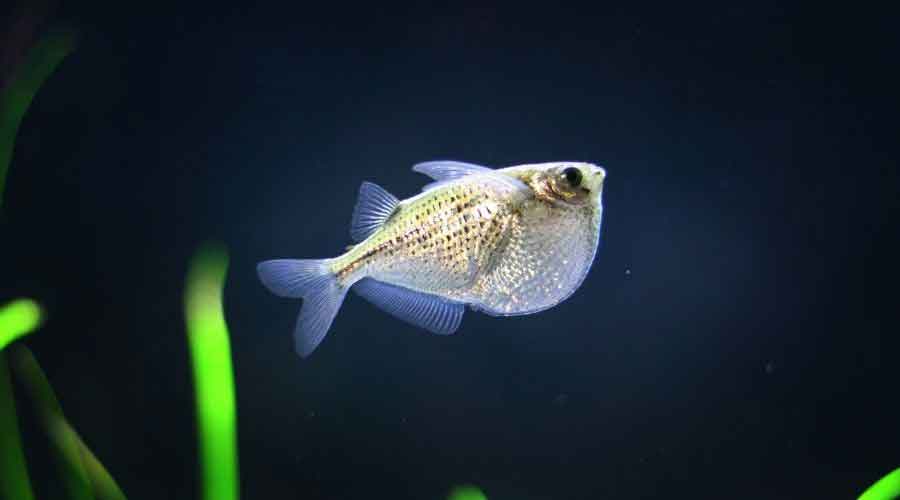 The hatchetfish, from the family Gasteropelecidae, was one of my first fish for my 10-gallon fish tank years back. I always thought he was an interesting looking fish and noticed how he liked to swim around the top of my tank. This worked out great because I also had a blue crayfish on the bottom of my tank that would have loved a snack.
The hatchetfish, from the family Gasteropelecidae, was one of my first fish for my 10-gallon fish tank years back. I always thought he was an interesting looking fish and noticed how he liked to swim around the top of my tank. This worked out great because I also had a blue crayfish on the bottom of my tank that would have loved a snack.
These fish are from South and Central America. They can actually jump out of the water and catch insects. Hatchetfish also come in many cool colors such as black, silver, gray, and other brighter colors. They are pretty easy to keep and can be fed fish flakes. They usually get along with most fish in the tank but might have problems with other male hatchetfish.
Hatchetfish live two to 5 years and grow to be about two and a half inches.
2. Danios: Another Popular Fish for Freshwater Tanks
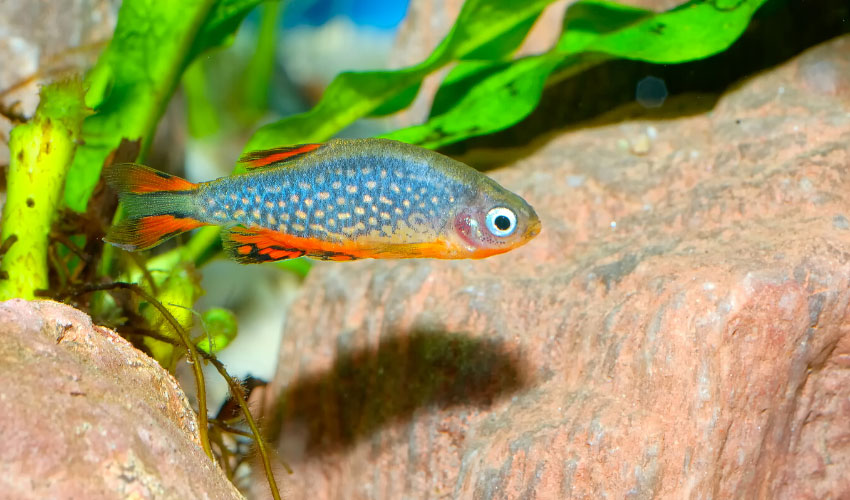 Danios, from the family Cyprinidae, are very popular freshwater fish and a great addition to community fish tanks in most cases. These fish are from Eastern India. They like to swim near the surface and middle of the tank and are pretty hardy fish. Actually, their swimming near the surface and middle of the tank is the reason I got mine because I also had my crayfish.
Danios, from the family Cyprinidae, are very popular freshwater fish and a great addition to community fish tanks in most cases. These fish are from Eastern India. They like to swim near the surface and middle of the tank and are pretty hardy fish. Actually, their swimming near the surface and middle of the tank is the reason I got mine because I also had my crayfish.
These guys are omnivores and have no problem living off of a steady diet of fish flakes. They can grow up to two inches long and have a lifespan of roughly five years.
Danios come in many different variations, such as the zebra danio, gold danio, blue danio, etc. Personally, I’m a fan of the zebra. Another good pick for the beginner—a great fish for freshwater tanks.
3. Betta Fish
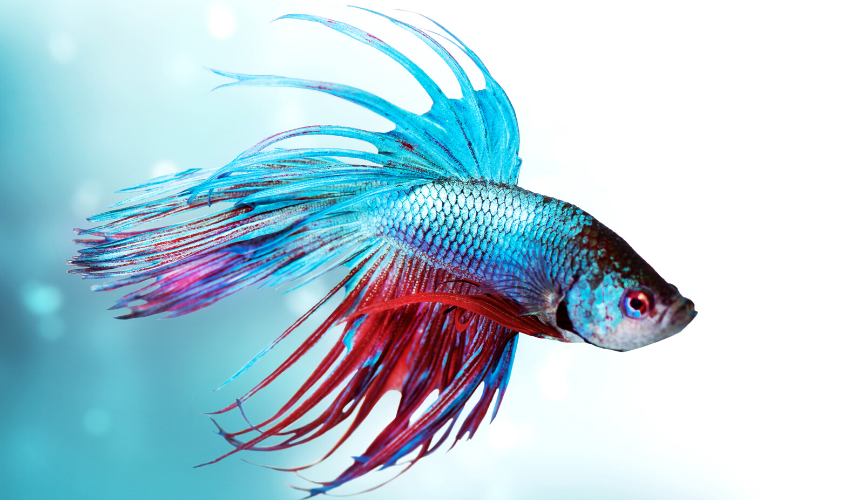 Betta fish are a part of the gourami family (Osphronemidae). These fish are very colorful fish with very impressive fins. They’re just flat out beautiful.
Betta fish are a part of the gourami family (Osphronemidae). These fish are very colorful fish with very impressive fins. They’re just flat out beautiful.
These fish are from Southeast Asia. The females can survive well in a community tank together. But, the males, on the other hand, are pretty aggressive and need to be kept alone.
When it comes to feeding, these fish need lots of protein in their diets. Although some fish flakes will work, it’s best to include a mix of live food sources that come from worms, daphnia, bloodworms, brine shrimp, mosquito larvae, and other fish.
These fish can grow to be about three inches long and live for about 5 years.
4. Mollies
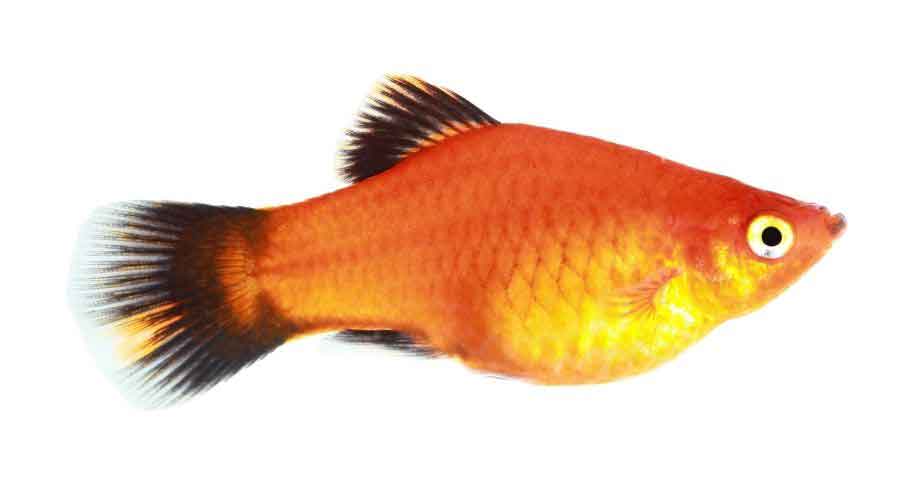 I’ve kept mollies over the years in my fish tanks. I’ve always thought there were very pretty fish. Plus, they can be another great addition to community fish tanks. Mollies are from the Poeciliidae family and come from North and South America. Their name is derived from the Greek word “Poecilia,” which means “many-colored.”
I’ve kept mollies over the years in my fish tanks. I’ve always thought there were very pretty fish. Plus, they can be another great addition to community fish tanks. Mollies are from the Poeciliidae family and come from North and South America. Their name is derived from the Greek word “Poecilia,” which means “many-colored.”
Mollies are omnivores and will eat almost anything. It’s suggested, however, that they are fed both plant matter and protein.
These guys only live for one to 2 years and grow to be about three inches.
5. Neon Tetras: The Most Popular Fish for Freshwater Tanks?
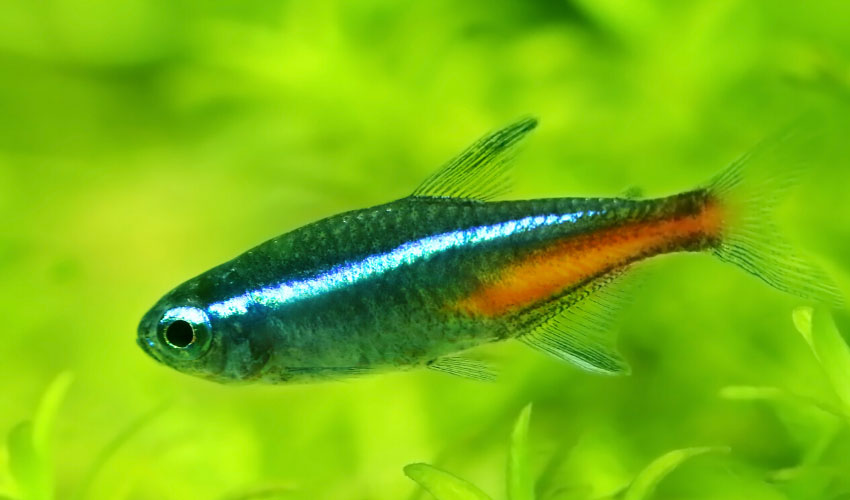 I’ve also had a couple of Neon Tetras over the years. Neon Tetras are from the fish family Characidae and come from South America. They are found in Colombia, Peru, and Brazil.
I’ve also had a couple of Neon Tetras over the years. Neon Tetras are from the fish family Characidae and come from South America. They are found in Colombia, Peru, and Brazil.
Tetras have a very pretty iridescent blue color. However, there is also a Golden Neon Tetra and the Diamond Blue Neon Tetra.
Tetras will do just fine on a diet of fish flakes. However, it’s recommended that they are fed brine shrimp, frozen bloodworms, and other live food from time to time.
Neon Tetras have a great disposition, and because of this, they are great for most community tanks.
These fish grow to be a little over one inch and live for 1 to 2 years. Note: Avoid abrupt water changes with Neon Tetras.
6. Rasboras
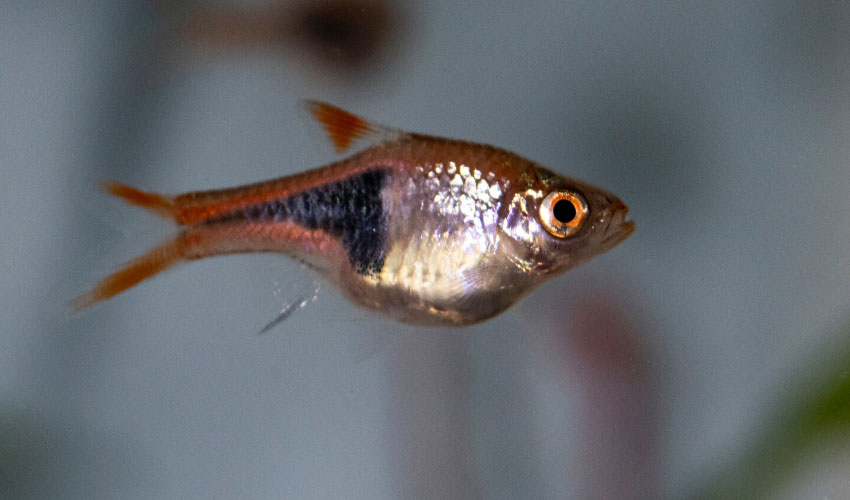 Rasboras are in the family Cyprinidae and are found in Southeast Asia and in certain parts of Southeast China. They are closely related to Barbs and Danios that are also on this list.
Rasboras are in the family Cyprinidae and are found in Southeast Asia and in certain parts of Southeast China. They are closely related to Barbs and Danios that are also on this list.
These fish come in vibrant colors of orange, red, black, and silver. Rasboras have a great temperament, are pleasant, and, therefore, great for community fish tanks. They do best in small schools (seven or more).
Rasboras are omnivores and can eat a mix of flake food and live food like bloodworms etc. The rasbora will live between five to eight years when cared for properly.
7. Tiger Barbs: Another Favorite Fish for Freshwater Tanks
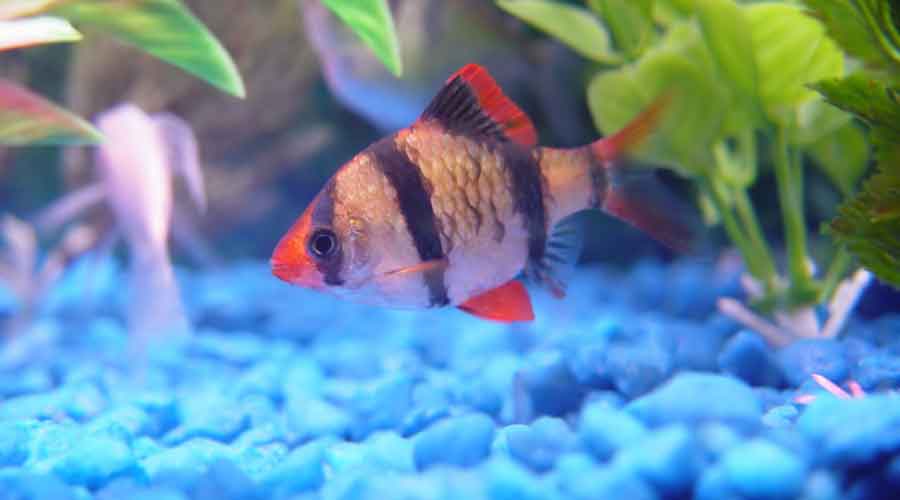 Tiger Barbs are just one type of Barb, and they are from the Cyprinidae family. They come with really cool black stripes, but other Barbs come in pink, red, yellow, gold, green, silver, and black.
Tiger Barbs are just one type of Barb, and they are from the Cyprinidae family. They come with really cool black stripes, but other Barbs come in pink, red, yellow, gold, green, silver, and black.
These are pretty popular fish for freshwater tanks. These fish come from the Malay Peninsula, Sumatra, and Borneo in Indonesia. There are some people that report seeing Tiger Barbs in Cambodia.
Barbs are a schooling fish and do best when kept in schools of 10 or more. When it comes to feeding, Tiger Barbs are omnivores. They are fine being fed fish flakes. Ideally, though, feeding these fish a combination of plant-based food and occasional live food works best.
Tiger barbs live for 6 to 7 years and grow to be almost three inches.
8. Rainbowfish: Beautiful
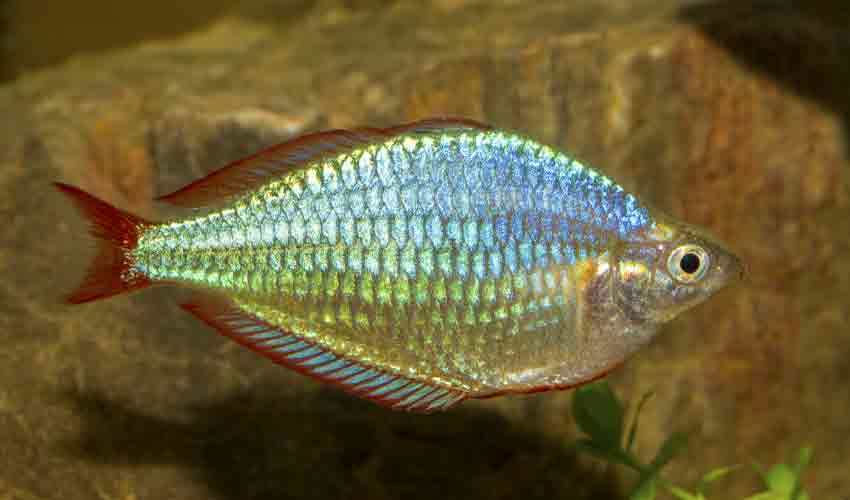 The Rainbowfish is a beautiful freshwater fish from the Melanotaeniidae family. This fish is known for its iridescent coloration. And, because of this, the color of the Rainbowfish changes when viewed from different angles in the light. Pretty cool eh?
The Rainbowfish is a beautiful freshwater fish from the Melanotaeniidae family. This fish is known for its iridescent coloration. And, because of this, the color of the Rainbowfish changes when viewed from different angles in the light. Pretty cool eh?
The Rainbowfish is from the Northern and Eastern parts of Australia, New Guinea, and can even be found in certain parts of Southeast Asia.
Rainbowfish are omnivores. Because of this, they should be fed a steady diet of both fish flakes and live food that includes different types of worms such as blood worms.
Rainbows or “bows” grow to be about two inches in most cases. And some Rainbows can live for up to 5 years.
9. Oscar: Easy Boy!
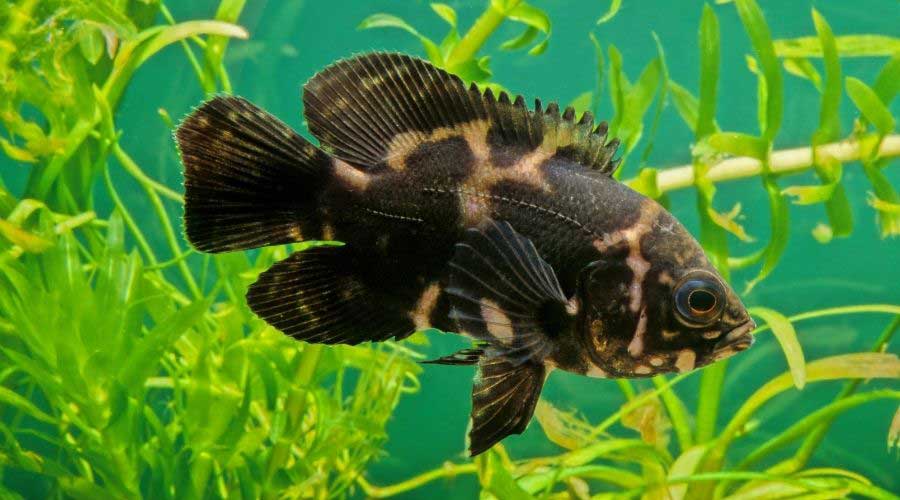 Oscars are from the fish family Cichlidae and come from the Amazon River basin in South America. And, Oscars are incredibly aggressive fish.
Oscars are from the fish family Cichlidae and come from the Amazon River basin in South America. And, Oscars are incredibly aggressive fish.
Because of their aggressiveness, they are known for fighting other fish in fish tanks. Also, these guys grow to be 14 to 18 inches and can get up to three pounds. So, getting a tank that is very large is imperative. By large, try 100+ gallons.
As you might imagine, these guys are carnivores. They can be fed meat-based pellets. Ideally, though, feeding Oscars a combination of fish, worms, shrimp, shellfish, beef heart, etc. is best.
Note, these fish put out a great deal of waste. Because of this, if you plan on keeping an Oscar, you will needy a pretty sturdy filtration system for your tank. When it comes to tank mates, you’ll need to pair Oscars with other aggressive to moderately-aggressive fish.
Oscars have a pretty long lifespan and can live between 10 to 20 years.
10. Plecostomus: A Freshwater Fish to Clean
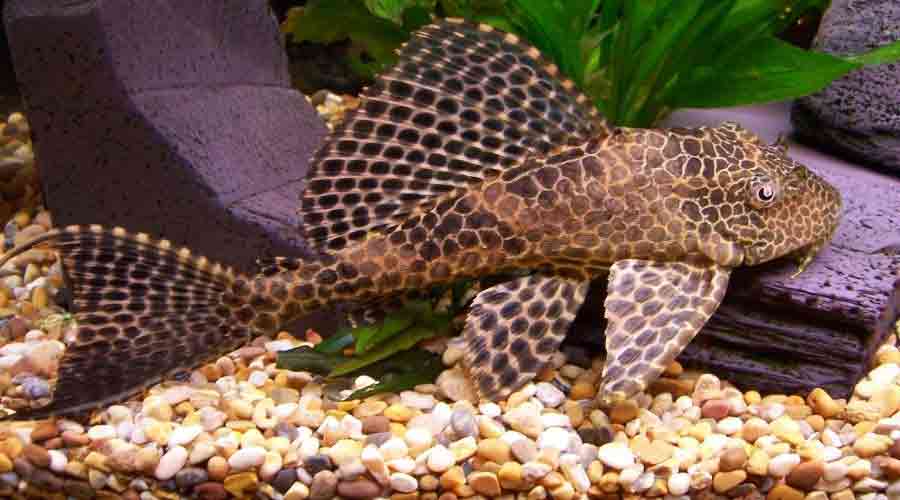 Also known as the “common pleco,” the Plecostomus is from Northeastern South America and is a pretty cool fish for freshwater tanks. It’s of the Loricariidae family. These catfish come in several different colors such as spotted, striped, different shades of brown, etc.
Also known as the “common pleco,” the Plecostomus is from Northeastern South America and is a pretty cool fish for freshwater tanks. It’s of the Loricariidae family. These catfish come in several different colors such as spotted, striped, different shades of brown, etc.
Most will describe the Plecostomus as being a planteater as he is great for cleaning up algae in any fish tank. However, the pleco has no problem eating crustaceans as well.
In the wild, these bad boys can grow to be 24 inches long. However, in an aquarium, they only grow to be only about 12 to 15 inches.
Plecos live on the bottom of the tank. So it’s not recommended to keep these with crayfish.
The pleco can live between 10 and 15 years.
11. Goldfish: Well-known, Peaceful, Dirty

Originally from China, the very popular Goldfish in the Cyprinidae family was one of the first species of fish to be domesticated. These fish are medium in size and do best in a bigger fish tank.
Goldfish also do very well when kept with other fish in groups of six or more. They have a very peaceful temperament and are pretty easy to care for.
Goldfish are omnivores and will live on flakes, pellets, and live foods. However, these fish do put out a lot of waste. So, adequate filtration is essential.
These fish can live between 5 to 10 years and can grow to be two to six inches long.
12. Clown Loach: Intelligent, Social
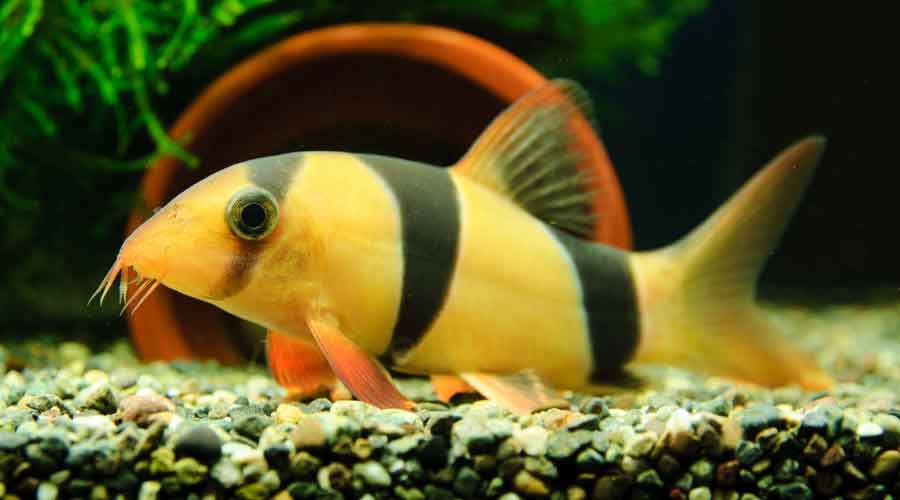 The clown loach is from the fish family Botiidae. There are over 200 different species of loaches.
The clown loach is from the fish family Botiidae. There are over 200 different species of loaches.
Loaches come from Central and Southern Asia. They are highly intelligent, social fish, and do great when paired together in small groups.
Clown loaches are bottom feeders and do well with pellet food. However, it’s also a great idea to supplement their diets with other vegetables.
Loaches live for up to 10 years and grow to be roughly around five inches in length. Everybody likes a clown loach.
13. Jack Dempsey: A Crazy-Aggressive Freshwater Fish
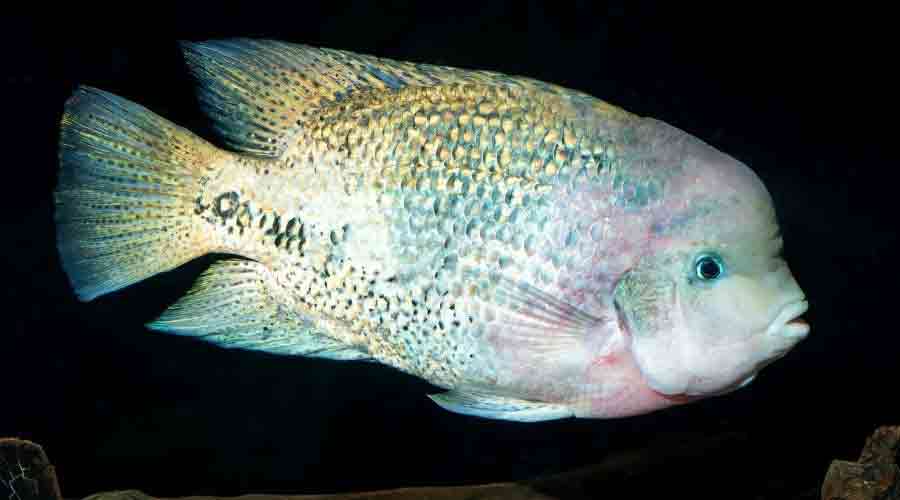 The Jack Dempsey, like the Oscar, is from the fish family Cichlidae. It comes from Central and North America. These guys are interesting fish and each Jack Dempsey comes with their own personality.
The Jack Dempsey, like the Oscar, is from the fish family Cichlidae. It comes from Central and North America. These guys are interesting fish and each Jack Dempsey comes with their own personality.
The Jack Dempsey is known for being pretty aggressive and doesn’t do so well with many fish. However, there are still tank mates out there for the Jack Dempsey. It’s best to keep these fish with other aggressive fish.
When it comes to feeding, the Jack Dempsey fish is a carnivore. They will do best being fed small fish, worms, crustaceans, and pellets and flakes specifically designed for cichlids.
They grow to be 10 to 15 inches and live to be 8 to 10 years old. For this reason, Jack Dempseys should be kept in larger tanks. These are probably not the best beginner fish.
14. Guppies: Very Popular
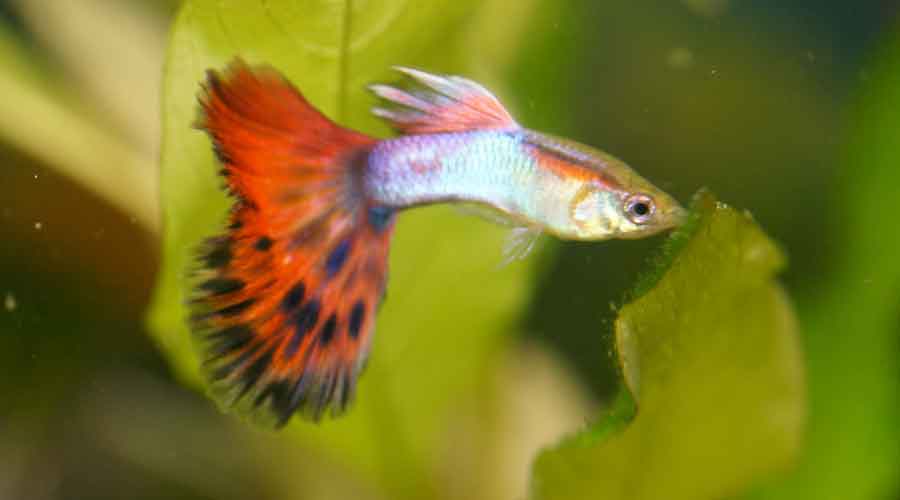 The Guppy is one of the most popular fish for freshwater tanks. It is of the family Poeciliidae and it comes from the Northeastern regions of South America.
The Guppy is one of the most popular fish for freshwater tanks. It is of the family Poeciliidae and it comes from the Northeastern regions of South America.
Guppies come in many different colors, have a great temperament, and are very hardy fish. This makes them a great fish for beginning aquarists.
Guppies are omnivores and can do just fine being fed fish flakes. But, it’s a good idea to switch up their diets using a combination of both fish flakes and vegetable matter.
Female guppies can grow to be about two inches while male guppies can grow to be about one and a half inches. They live for about one to three years.
15. Red Tail Shark
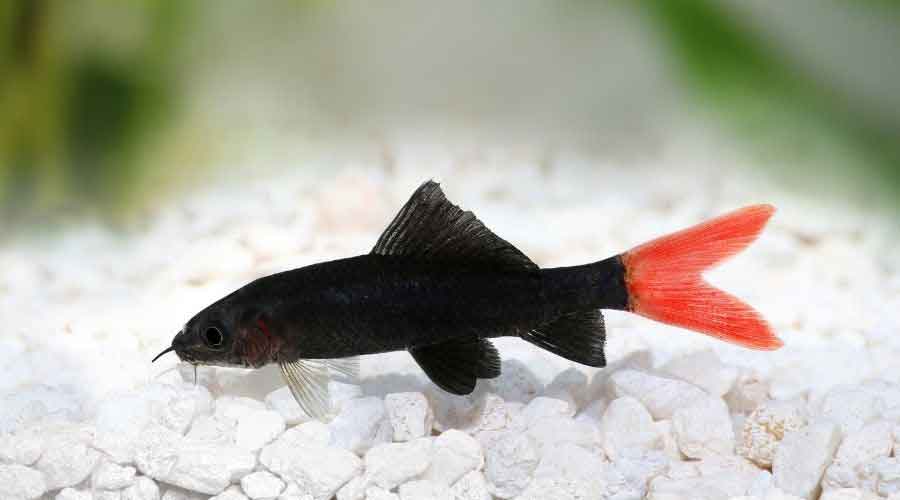 Red tail shark, or epalzeorhynchos bicolor, are originally from Thailand. However, these fish are completely extinct in that region. But, thanks to the aquarium trade, these fish are making a comeback.
Red tail shark, or epalzeorhynchos bicolor, are originally from Thailand. However, these fish are completely extinct in that region. But, thanks to the aquarium trade, these fish are making a comeback.
The red tail shark will eat plants like algae, but will also eat animals such as worms and crustaceans.
The red tail shark is not actually a shark. These fish are territorial though and will chase other fish around the fish tank.
Ideally, the red tail shark needs a bigger tank as they can grow to be six inches long and live for up to 8 years.
16. Rainbow Shark: Beautiful Fish for Freshwater Tanks, If You’re Careful
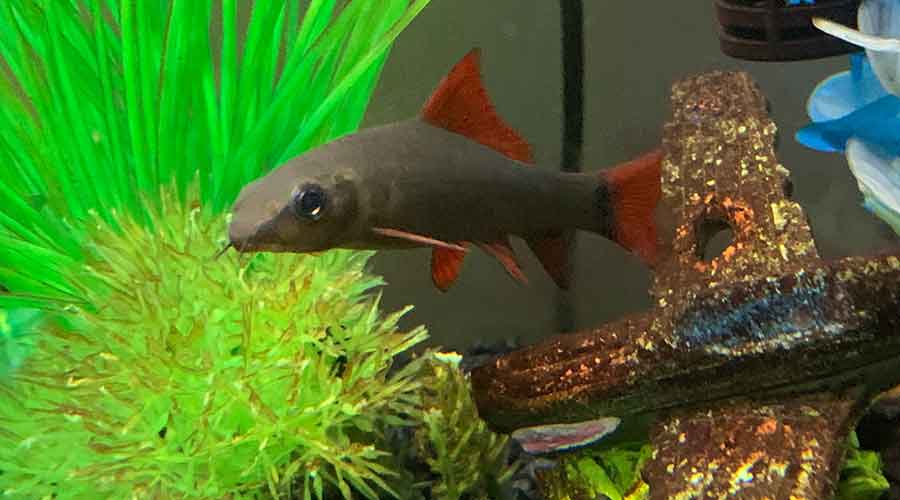 The rainbow shark (Epalzeorhynchos frenatum) is another great fish for freshwater tanks. It is originally from Thailand.
The rainbow shark (Epalzeorhynchos frenatum) is another great fish for freshwater tanks. It is originally from Thailand.
These guys are omnivores from the Cyprinidae family. I currently have a rainbow shark in my tank (that’s him in the pic). Rainbow sharks can be pretty territorial but when paired with the right types of fish, there shouldn’t be any problems.
These fish are really fun to watch as they glide through the tank from one side to the other effortlessly. They are dark gray and orange in color and omnivores. They will do just fine feeding on algae tablets.
Rainbow sharks need about a 55-gallon tank to truly be comfortable. They grow to be roughly six inches long and can live for as long as 8 years. Note, never put this fish in a tank with another rainbow shark or a fish that looks similar.
17. Blue Crayfish: Not Exactly a Fish, But…
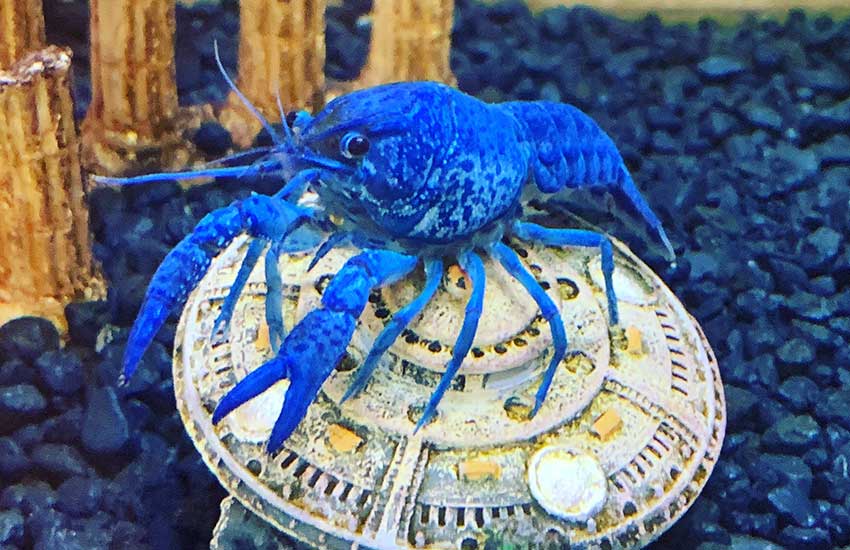 The blue crayfish is another great addition to an aquarium, although these guys are not fish. Blue crayfish are of the family Cambaridae and are native to Florida. However, these crayfish are also found in the states of Tennessee, Kentucky, North Carolina, and others.
The blue crayfish is another great addition to an aquarium, although these guys are not fish. Blue crayfish are of the family Cambaridae and are native to Florida. However, these crayfish are also found in the states of Tennessee, Kentucky, North Carolina, and others.
Blue crayfish have personalities of their own and are very interesting to watch. They like to burrow, build their own hideouts, and hunt. They are very hardy and pretty easy to keep. However, because of their aggressive nature, they can’t just be kept with any fish. Here’s a list of some good tankmates for blue crayfish.
Blue crayfish are omnivores and scavengers. They will eat fish, plants, and almost anything you feed them. These guys live for five to 6 years and can grow to be five to six inches long.
How can you not love the blue crayfish?
18. Pea Puffer Fish
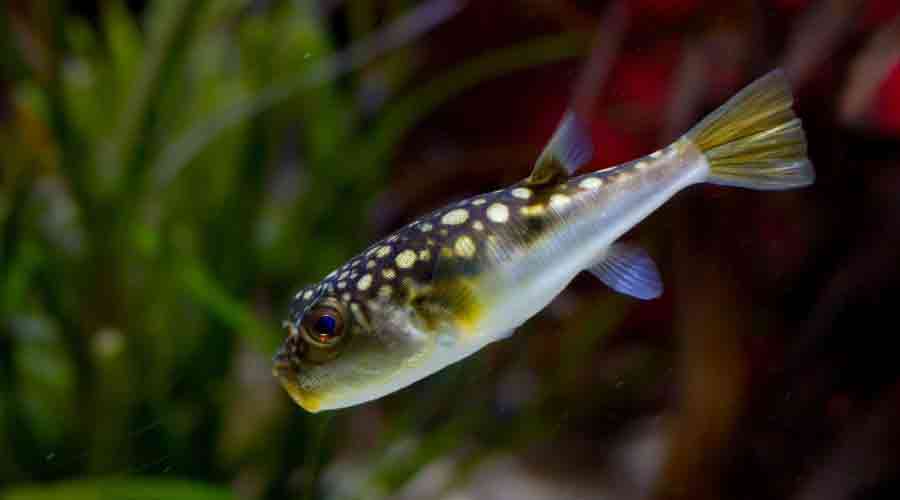
Check out this little guy, the pea puffer fish that is from the tetraodontidae family. They also go by names like pea puffers, the dwarf crayfish, and the pygmy puffer fish.
These aren’t exactly known for being rare, but they are known for being unique. The reason is that they are just one of a few puffer fish that can live in freshwater.
The pea puffer fish is native to Southwest India. They have unique color patterns and are also known for their eyes that move independently of one another.
The dwarf puffer fish does not grow to be large, roughly one inch, but they can be a great addition to freshwater tanks. Of course, this always depends on what else you are keeping in your tank.
Note, the care-level of this fish is intermediate. So it might not be a great fish for those just getting started with a fish tank.
As far as care, puffers will eat brine shrimp, and various worms, like blackworms.
Make sure the tank is fully cycled before adding your puffers to the tank. It’s also a good idea to provide hideouts for the dwarf crayfish.
Additionally, remember that these guys are semi-aggressive even though they aren’t so big. Pea puffers grow to be 1 inch and can live for up to 10 years. That’s a long time for such a small fish. For many, the pea puffer is a favorite fish for freshwater tanks.
19. Cory Catfish
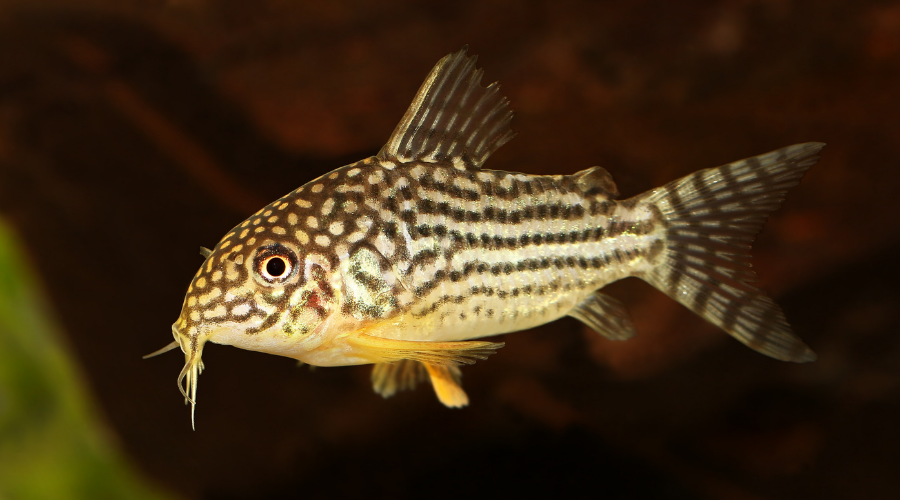 This is a really cool fish with a unique and beautiful look all its own. The cory, from the callichthyidae family, and native to South America, also has a great temperament. This means it’s a good fish for most community tanks as long as the other fish also have good dispositions and aren’t aggressive. I’d suggest tank mates such as tetras, danios, and mollies for the cory.
This is a really cool fish with a unique and beautiful look all its own. The cory, from the callichthyidae family, and native to South America, also has a great temperament. This means it’s a good fish for most community tanks as long as the other fish also have good dispositions and aren’t aggressive. I’d suggest tank mates such as tetras, danios, and mollies for the cory.
Also, these guys do best when swimming in small groups. So you might consider getting more than one.
The cory catfish is a hardy fish and can survive in different types of water conditions. Like most catfish, they swim on the bottom of the tank.
This fish can live off of flakes, sinking pellets, and bloodworms. But, it’s probably best to switch up their diet a bit. When it comes to fish tanks, ideally, I’d say that a 20-gallon fish tank is going to work best, especially if you plan on keeping any other fish.
You can expect the cory to grow to 2.5 inches and live up to 5 years.
20. Arowana
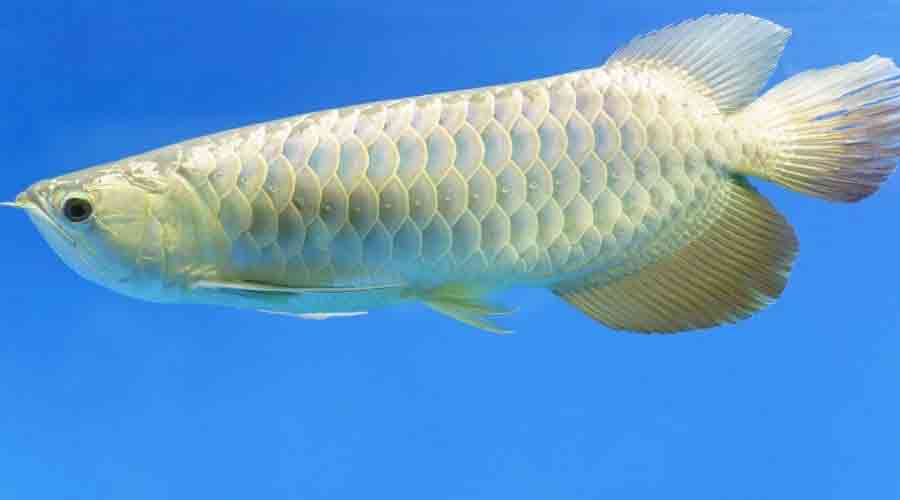 The Arowana, or osteoglossum bicirrhosum, is a unique fish. It’s on the endangered species list and is actually illegal own in the United States and other parts of the world.
The Arowana, or osteoglossum bicirrhosum, is a unique fish. It’s on the endangered species list and is actually illegal own in the United States and other parts of the world.
The Arowana is extremely aggressive and territorial, and because of this, it should be kept in large tanks and can only be kept with certain types of fish.
These Arowana can be found in all different parts of the world such as Africa, South America, Australia, and Asia.
Arowana can grow to be four feet long, but in captivity, most reach three feet long. This is one of the many reasons that Arowana need larger tanks, around 125 gallons should do.
Additionally, the Arowana is a very carnivorous eater. They do best being fed a combination of krill, worms, ghost shrimp, and insects.
These guys can live for 10 to 15 years and are not recommended for new aquarists.
Interesting fact: did you know that the platinum Arowana can go for thousands of dollars? Also, did you remember that this fish is illegal to own in most parts of the world?
21. Mexican Dwarf Crayfish
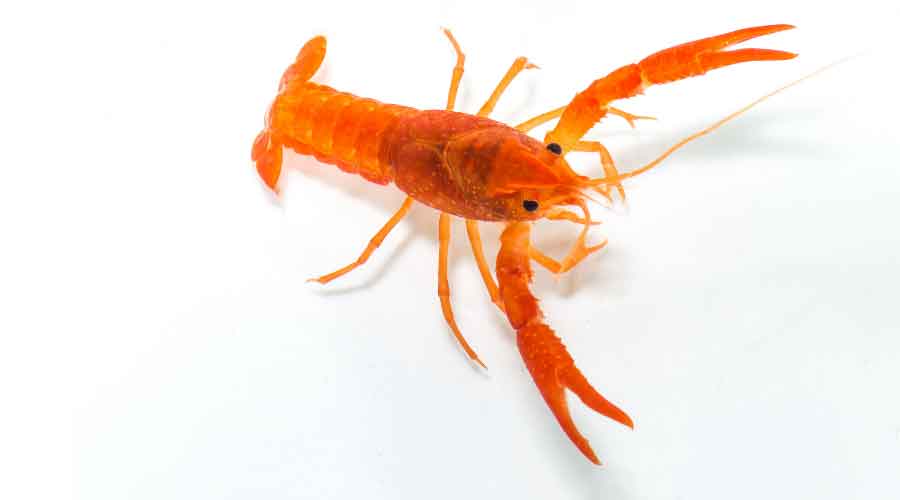 No, it’s not exactly a freshwater “fish,” but, it can live in the tank with a lot of freshwater fish and I thought it should be on the list because it is so striking.
No, it’s not exactly a freshwater “fish,” but, it can live in the tank with a lot of freshwater fish and I thought it should be on the list because it is so striking.
Unlike other types of crayfish, the red swamp crayfish, and the blue crayfish, the Mexican dwarf crayfish has a pretty good temperament. The Mexican dwarf crayfish, from the cambaridae family, is obviously native to Mexico.
The Mexican dwarf crayfish can grow to be between 1 to 2 inches and will live for about 2 years.
Additionally, these crayfish are pretty easy to care for and can live off of sinking pellets, brine shrimp, and bloodworms.
Good tank mates for these crayfish are neon tetras, guppies, platies, and hatchet fish.
22. Red Texas Cichlids
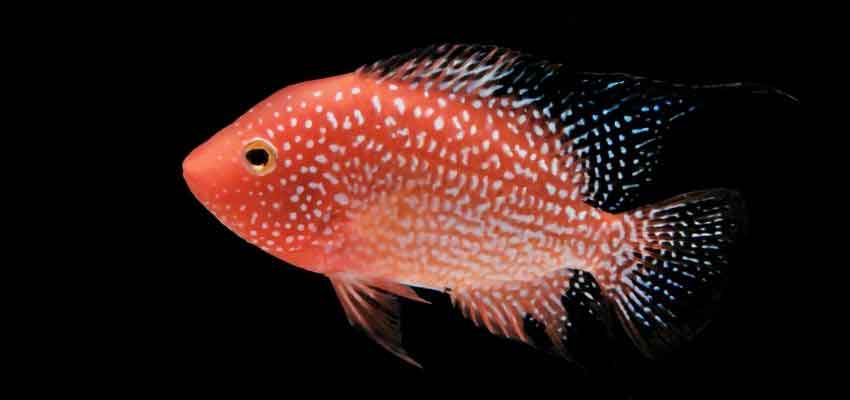 Red Texas cichlids are a very unique fish and highly sought after. And, the breeding of these freshwater fish is undoubtedly pretty interesting and difficult, to say the least.
Red Texas cichlids are a very unique fish and highly sought after. And, the breeding of these freshwater fish is undoubtedly pretty interesting and difficult, to say the least.
The red Texas cichlid is an intergeneric hybrid. They are bred from green Texas male cichlids and female blood parrots. Female blood parrots are hybrids themselves. So they are not found in nature. But, of course, the green Texas male cichlid is found in northern lakes and rivers of Mexico and also in southern parts of Texas.
The breeding of these fish is the hard part. That’s because the majority of the fry never grow to display the full bright red hallmark colors of the red Texas cichlid. Plus, they change as they grow.
Since the fish are so rare, they are pretty expensive with a price tag of about $350.
Red Texas cichlids are aggressive fish, very aggressive actually. So if you are going to keep them with other fish, you’ll want a bigger tank and you’ll also want to keep them with fish that are also aggressive. They can work well with fish like the large catfish, the Jack Dempsey, and Oscars.
These fish are omnivores. They will eat earthworms, insects, freeze-dried krill, ghost shrimp, etc.
The red Texas cichlid can live for around 13 years.
23. Elephantnose Fish
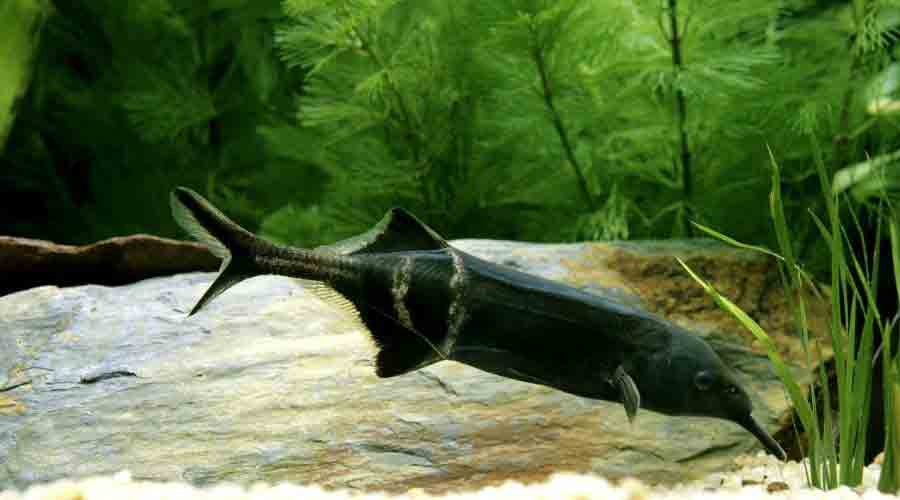 The elephantnose fish is another one of those very unique and extremely interesting freshwater fish. It’s a member of the Mormyridae family.
The elephantnose fish is another one of those very unique and extremely interesting freshwater fish. It’s a member of the Mormyridae family.
If you end up with this fish in your aquarium, people will definitely turn their heads to take a look.
Elephantnose fish are inhabitants of the Niger River. The elephantnose fish is obviously named for its long elephant-like trunk. This trunk is pretty interesting, too. Not only do they use it to eat with, but they also use their trunks to communicate and for self-defense.
Elephantnose fish have an electrical field that they use to detect what is going on in their surroundings. This works out well because this fish is known for liking muddy dark waters that are filled with plants and cover. These guys are also known for being active at nighttime. So a little help with direction and detection of surroundings is great for the elephantnose fish.
The elephantnose is carnivorous and can be fed a mixture of blood worms, chopped earthworms, brine shrimp, and pellet food.
The elephant nose fish is only recommended for more experienced fish keepers. That’s because they have very specific water requirements in captivity.
These beautiful fish can grow up to 9 inches and can live for up to 10 years when properly cared for. That’s a decent amount of time for a fish.
If you plan on keeping an elephantnose fish, just remember that these guys are also semi-aggressive. So you will need to be careful about what other fish you keep in the tank. It’s also recommended that their fish tanks be no smaller than fifty gallons.
24. Discus
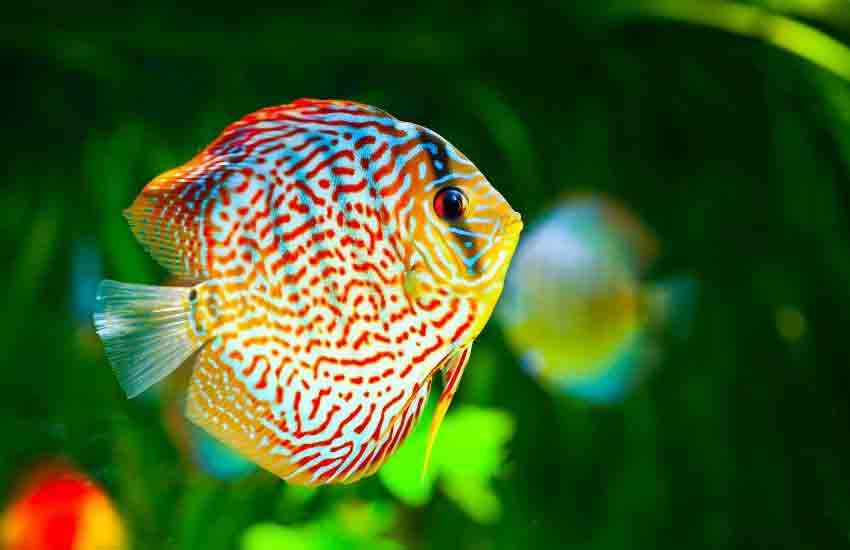
The list wouldn’t be complete without the discus. The discus is a beautiful fish that can easily become the star of the tank because of its breathtaking colors.
Discus are members of the family Cichlidae. They are found in and around the Amazon river basin including some of its tributaries.
Discus like calm and pristine water. So when keeping these fish, it’s essential to keep the water healthy and clean by doing weekly 10 to 20% water changes.
The discus can grow to be roughly five to six inches in length. So it’s recommended they be kept in about a 75-gallon fish tank. The tank can also be decorated with plants, driftwood, and even a couple of cool fish tank ornaments.
The discus is not only picky with its water, but also with its tank mates. Generally speaking, the discus is a peaceful fish. However, these guys can become a bit aggressive when mating. The discus can be kept with tank mates like clown loaches, dwarf cichlids, and cardinal tetras. Be sure not to keep the discus with fish that can’t hold their own, though.
The discus is an omnivore and can be fed live and frozen foods as well as tropical fish flakes. However, it’s always best to switch up their diet some.
The discus is not a fish for beginners. When cared for correctly, owners can enjoy this fish for ten to 15 years.
25. Alien Betta Blue Hybrid
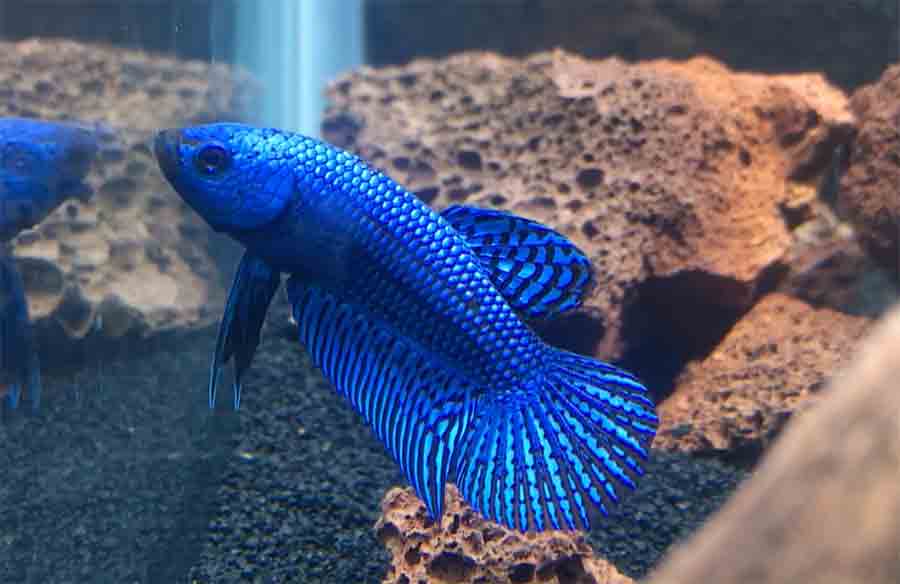
The blue alien hybrid betta or alien betta blue hybrid will make you do a double-take. Sometimes called the “royal blue,” blue aliens are a hybridization of different wild bettas and they are absolutely stunning.
The blue alien hybrids are extremely aggressive fish and it’s recommended that they be kept alone or in fish tanks with non-male betta tank mates.
These bettas also do well in smaller tanks that are planted. Tanks that are between 2.5 to 20 gallons.
The blue alien will grow to just over two inches and they live for about 3 years.
Being bettas, these guys are carnivores and enjoy a diet that consists of bloodworms, brine shrimp, tubifex worms, and betta pellets.
26. Swordtails
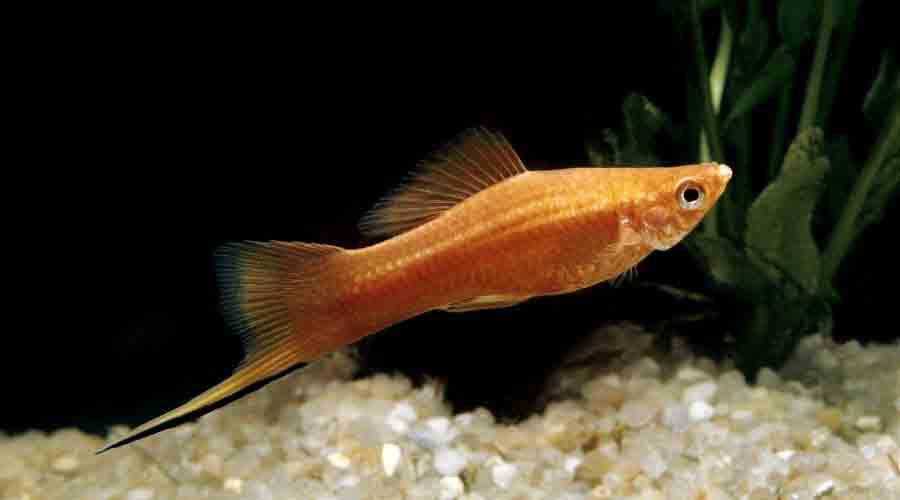
The swordtail is a beautiful fish that comes in quite a few colors. It’s a member of the Poeciliidae family and is found in North and Central America. These fish come in orange, black, striped, and then there is the hamburger swordtail. The hamburger swordtail is a hybrid.
This is a great fish for the beginning aquarist as it’s hardy and is pretty peaceful. It will do well in a community fish tank.
This fish is an omnivore that can eat fish flakes and algae. It will also do well eating freeze-dried bloodworms, and brine shrimp.
Swordtails can grow to be roughly 5.5 inches, and females can grow up to an inch longer.
The swordtail, when cared for properly, can live up to 5 years.
27. Killifish
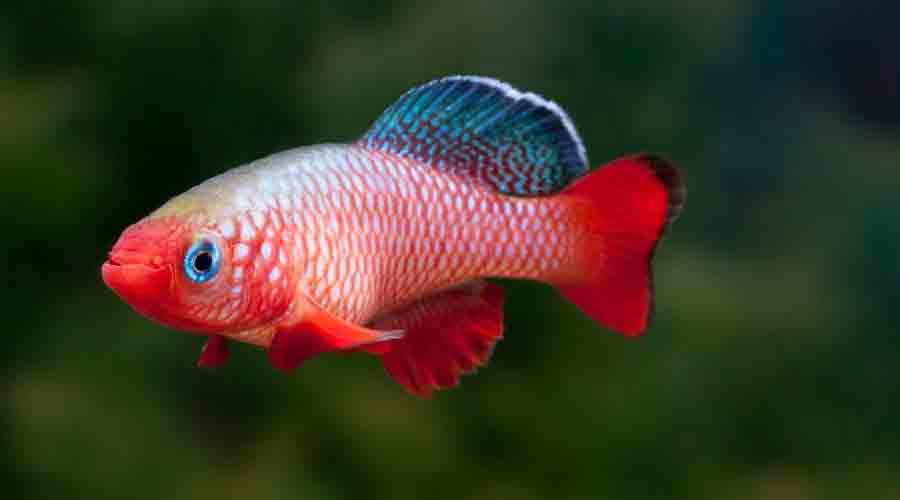
The killifish is another beautiful fish for freshwater tanks. They are members of the Cyprinodontidae family and can be found in almost any place in the world, excluding Antarctica and Australia.
There are many killifish variations in both colors and their body shapes, fins, etc.
Killifish are great for community tanks. For the most part, they are peaceful fish and can be kept in tanks with other smaller freshwater fish. There is one catch, though. Killifish can be a bit aggressive with other male killifish.
If you decide to keep this fish with other tropical fish, consider fish like danios, tetras, and hatchetfish.
Most killifish will are relatively small, just one to two inches. However, the larger species can grow to be almost six inches.
These fish are carnivores. So they can be fed brine shrimp, daphnia, bloodworms, and mosquito larvae. As always, it’s a good idea to switch up their diet.
When cared for properly, the killifish will live between 2 to 5 years.
A Recap on Fish for Freshwater Tanks
There is a large selection of fish for freshwater tanks out there to choose from. All types of beautiful fish with different dispositions, colors, and other attributes. But, before you buy any fish, it’s extremely important to plan out your tank out. You want to ensure that your fish will get along with each other. Also, you want to ensure your fish tank is big enough. And, if you are a beginner, make sure that you condition the water and cycle the tank before adding fish. This is critical if you want to have a successful fish tank.
If you are just getting started in the aquarist hobby, I’d suggest starting off with a 20-gallon fish tank and a few hardy fish. Fish like danios, tetras, tiger barbs, and guppies would be great choices. As you progress in the hobby, you’ll learn more about fish and fish care and can decide if you want to turn things up a notch with some of these other exciting freshwater fish.
What to consider before buying fish for a fish tank:
- What different types of fish do you plan on keeping?
- How big of a tank are you going to have?
- Are the fish you want in your tank compatible with each other?
